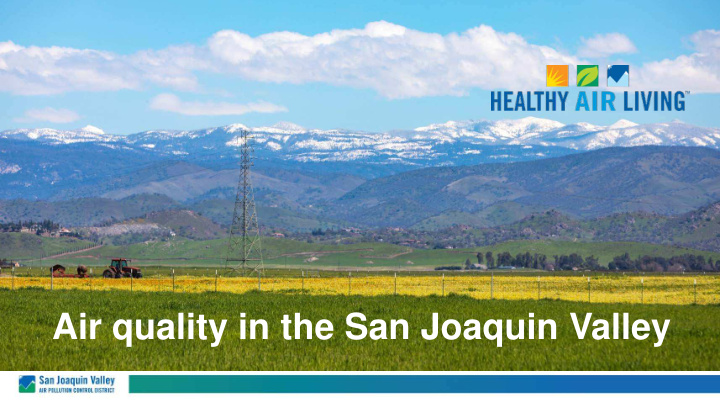



Air quality in the Air quality in the San Joaquin Valley San Joaquin Valley and you
Valley Air District • Regional agency responsible for air quality in 8 counties - San Joaquin, Stanislaus, Merced, Madera, Fresno, Kings, Tulare & the valley air basin portion of Kern • 15 member Governing Board • Regulates stationary sources • Provides grant funding • Responsible for meeting EPA & CARB mandates to improve public health 2
The District’s Mission The e San San Jo Joaq aquin Val alley ey Ai Air r Dist istric ict is is a public lic healt lth agency y whose se m missio ission is is to impro rove e the e heal ealth an and q qual ality of lif life f for a all ll Valle lley r y resid sidents s thr hroug ugh e h eff fficient nt, e eff ffective an and en entrep repren reneu euri rial al ai air q r qual ality man anagem agemen ent s strat rategi egies es. 3
Valley Challenges Unmatched • Surrounding mountains and meteorology create ideal conditions for air pollution formation and retention. • High rate of population growth, I-5 and Hwy 99 (major transportation arteries) run all the way through Valley. • These challenges make it exceedingly difficult to meet federal, health-based ambient air quality standards for Ozone and PM 2.5. 4
Ozone • Ozone: Main component of summertime ‘smog.’ • Odorless, colorless, corrosive gas, resulting from chemicals cooking in sunlight and heat. • Made up of nitrogen oxides (NOx) and volatile organic compounds (VOCs). • Most of the precursor emissions come from internal-combustion engines (mobile sources), industrial processes, agriculture, consumer products (lawnmowers, paints and solvents, etc). • Motor vehicles account for up to 80 percent of the Valley’s smog. 5
Sources of Air Pollution 6
7
Particulate Matter PM2 PM2.5 (Par articulat ate Mat Matter, 2.5 microns an and smal aller) • • Winter problem: Emissions from burning in fireplaces and wood stoves. • Also generated during wildfires. • More dangerous than larger particles because PM2.5 can travel deeper into the lungs. • High concentrations can trigger heart attacks, strokes, aggravate asthma and bronchitis; and increase susceptibility to respiratory infections. • Strong correlation between PM levels, hospital admissions and premature death. PM1 PM10 ( (Par artic iculat ate Mat Matter, 1 10 microns an and smal aller) • Fall problem. Mostly dust and larger particles. 8
9
Progress to Date • 92% reduction in emissions from Valley businesses • Reached attainment of the PM10 Standard in 2005 • First and only region in nation to go from “Extreme” classification to attainment of 1-hour Ozone Standard • Historic progress possible through investment and sacrifice by businesses and residents • 2018 PM2.5 Plan demonstrates strategies for attainment by 2025 deadline 10
2019 record-setting year for ozone progress Design value describes the air quality status of a given location relative to the level of the National Ambient Air Quality Standard (NAAQS). 11
2019-2020 winter season cleanest on record 12
Receive current air quality information • RAAN – Real-Time Air Advisory Network - Online or mobile device access to real time, hourly air-quality information for your area, 24 hours a day - Access to actual concentrations of ozone and PM2.5 - Outdoor activity recommendations based on five different levels • Access RAAN – www.myraan.com – Free “Valley Air” app 13
Valley Air App 14
• Engagement with Valley schools • Educating children, parents and teachers on air quality and District programs • Protecting health and well-being of Valley children/students • Encourage use of District’s RAAN (Real-time Air Advisory Network) as a tool to modify outdoor activities based on air quality • Anti-idling campaign (Eng/Sp signs available) • Annual calendar contest • Healthy Air Heroes Activity Kits for grades K-6 15
Grants and Incentives • Business • Public agencies • Residents • Technology In 2019, the District invested more than $250 million in clean air projects. To date, the District has committed more than $2 billion, helping reduce approx. 140,000 tons of emissions. 16
What you can do • Reduce vehicle emissions by carpooling, riding the bus, walking or riding your bike • Avoid vehicle idling • Seek ways to reduce energy at home and work • Check Before You Burn or refrain from burning • Use air-friendly lawn equipment • Consider switching to an electric vehicle • Keep gasoline vehicles well-tuned • Take advantage of the many Air District grant programs: valleyair.org/grants/ 17
Need more information? Contact Outreach and Communications public.education@valleyair.org Fresno office (559) 230-6000 Modesto office (209) 557-6400 Bakersfield office (661) 392-5500 For information on District rules and programs visit: www.valleyair.org www.healthyairliving.com Use the Valley Air Follow us on App for the latest social media air quality info. 18
Recommend
More recommend